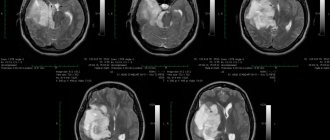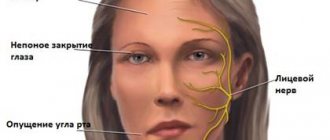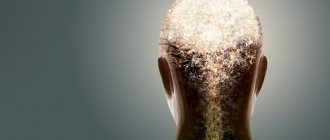Excited brain
In antiquity, epilepsy was called a “sacred disease” sent by the gods. On the one hand, its manifestations were frightening, but on the other, people suffering from this disease often had outstanding abilities. In the modern understanding, epilepsy is a heterogeneous group of diseases, the clinical picture of which is characterized by repeated convulsive attacks (fits). They arise as a result of synchronous excitation of all neurons of a separate area of the cerebral cortex - the epileptogenic focus. Sometimes an epileptic attack is preceded by an aura, manifested in the form of unexplained lightheadedness, sound or visual disturbances, depending on the location of the epileptic focus. Seizures occur as brief, involuntary spasms in one part of the body (partial seizures) or throughout the body (generalized seizures). Generalized seizures are often accompanied by loss of consciousness.
Article on the topic What to do if you have epilepsy, and how to help during an attack? Advice from a scientist Seizures can happen less than once a year, or up to several times a day if the disease is severe. Often the causes cannot be determined, and then they talk about idiopathic epilepsy. An international group of scientists led by specialists from the University of Melbourne found that 12% of idiopathic epilepsy is caused by a mutation of the DEPDC5 gene (the protein encoded by this gene is involved in signal transmission within neurons).
Secondary, or symptomatic, epilepsy can have the following causes: brain damage in the prenatal or perinatal period (hypoxia or birth trauma), head trauma and stroke causing brain hypoxia, brain infection, such as meningitis and encephalitis, parasitic diseases, brain tumor. There is also so-called cryptogenic epilepsy. This diagnosis is made when the cause of generalized symptomatic epilepsy cannot be accurately determined from research results.
An epileptic seizure can be triggered by factors affecting brain activity: hormonal changes (in particular, menstruation), flickering light or flashing images (when riding a train, in a car), intoxication (alcohol, some medications, toxic substances). There are also equivalents of epileptic seizures in the form of sudden onset mood disorders, disorders of consciousness, and also, in the case of severe disease, characteristic changes in personality and intelligence.
Two diseases are directly related to the course of epilepsy: migraine and depression. Epidemiological studies have shown that every fourth patient with epilepsy suffers from migraine, and the incidence of epileptic seizures in people with migraine reaches 17% or higher. In this case, depression is detected in 20–55% of patients with constant seizures and in 5–10% of people with controlled seizures. This association is most often observed in patients with a partial form that is resistant to treatment.
Article on the topic
Expert: A cure for epilepsy can be achieved in 65-75% of patients. Often, depression in epilepsy is not diagnosed, but that is exactly what it is, according to a study conducted at the Department of Nervous Diseases, Faculty of Postgraduate Education, Perm State Medical University named after. I.M. Sechenov, is the most important factor influencing the patient’s quality of life (its influence is higher than that of epilepsy itself).
Pathogenesis and causes of development
The mechanism for the development of epilepsy lies in changes in the activity of neurons in the brain. Sudden depolarization leads to the development of focal or widespread attacks.
Heredity
It is difficult to say that epilepsy is inherited. Genetic mechanisms and types of inheritance are not fully understood. Epilepsy within a family can be diagnosed in 40% of cases, especially for generalized seizures. In this situation, the predisposition to the development of epilepsy is caused by the special structure of neural connections and the ratio of chemicals that regulate their activity.
Acquired epilepsy
Causes of acquired epilepsy include:
- traumatic brain injuries (in children can be caused by perinatal brain damage during childbirth);
- cerebrovascular accident, stroke;
- neoplasms;
- alcohol and other intoxications;
- atherosclerotic damage to cerebral vessels;
- diseases of the brain of an infectious nature (meningitis, encephalitis and others).
Provoking factors
If there is a predisposition to epilepsy, exposure to provoking factors can lead to the development of the disease. These include:
- frequent overwork;
- stress;
- sleep disturbance;
- frequent climate change;
- exposure to sharp irritants (light and sound, industrial workers are especially susceptible);
- medications (certain groups of substances artificially cause the activity of brain neurons);
- alcohol.
At the first symptoms of the disease, you should immediately consult a doctor. Treatment of epilepsy, if diagnosed early, is guaranteed to improve the patient's quality of life.
Curability has been proven
According to the European Commission on Epilepsy, this disease affects about 50 million people, or up to 1% of the world's population. In Russia, according to the Ministry of Health, epilepsy occurs with a frequency of 1.1 to 8.9 cases per 1000 people, but, according to experts, this disease is not sufficiently diagnosed. According to the chairman of the Russian Anti-Epileptic League, Professor Gagik Avakyan, in the vast majority of medical institutions epilepsy is detected using routine electroencephalography, the effectiveness of which is at best 30%. But to make an accurate differentiated diagnosis, at least a 12-24-hour video-EEG is required, capturing the time of night sleep (the effectiveness of the method is 88-95%). This procedure is usually available in paid medical institutions.
Few people know that 70% of children and adults newly diagnosed with epilepsy can be successfully treated (that is, seizures are completely controlled) with antiepileptic drugs. After two to five years of successful treatment, approximately 70% of children and 60% of adults can stop taking medications without risk of relapse. After this, if the patient follows the basic rules of the regime: sleeps for 7–8 hours, completely abstains from alcohol, the attacks, as a rule, do not return.
Article on the topic
“We are superfluous everywhere.” The story of a family raising a child with epilepsy Yet in developing countries, three quarters of people with epilepsy do not receive the treatment they need.
In Russia the situation is, of course, better, but different from that in developed countries. “Over the past 20 years, a lot of work has been done in pediatric epileptology, but at the same time, there is no reliable connection between pediatric and adult services,” says Professor Andrey Petrukhin, President of the Association of Epileptologists and Patients . “The adult neurological network is not ready to accept the patient and continue his treatment with an effective drug, which leads to loss of remission.”
Indeed, patients with epilepsy are observed either by neurologists or psychiatrists who are not able to understand the intricacies of diagnosis and treatment of this complex disease. Epileptologists in Russia are trained within the framework of postgraduate education programs, in particular at the Russian National Research Medical University named after N.I. Pirogov, but so far there are specialists not in all regions.
The problems also include the inaccessibility of drugs, and this is not only due to the high cost of the latter. “Unfortunately, new drugs are often unavailable to Russian patients due to the fact that they have not been registered in the Russian Federation,” says epileptologist, Ph.D. Yuri Shiryaev (University Headache Clinic) . “We do not have the right and opportunity to use effective medications recognized by the world medical community.”
Surgical methods of treatment
Surgery is acceptable in patients in whom drug therapy is ineffective. It is preceded by a detailed examination of the patient and an assessment of the risks of the recommended manipulation. In most cases, the task of the operating specialist is to resect the epileptogenic part of the brain.
When performing a surgical operation, it is important to preserve significant areas of the brain responsible for speech, movement, sensitivity, etc. In cases where removal of the lesion is impossible, methods are used aimed at blocking signals from the epileptogenic zone.
If there are multiple foci of epilepsy and a low probability of success of standard surgical interventions, the patient may be recommended neuromodulatory operations (stimulation of the vagus nerve or stimulation of deep brain structures).
The main indication for surgical intervention is complete resistance to existing medications or a complicated medical history of the patient. Surgery may be recommended for the following concomitant diagnoses:
- brain tumors;
- mesial temporal sclerosis.
Surgical treatment of epilepsy also has a number of contraindications, which include the presence of aggressive progressive tumors, serious cardiovascular diseases and primary generalized seizures with loss of consciousness.
Absolute evil
However, in recent years, specialists have encountered an unexpected problem associated with the government’s attempt to save on treatment at any cost. Expensive but effective original drugs are being replaced by cheap generics, which win tenders for preferential provision of drugs. “In epileptology there is a golden rule, recognized as an international standard of treatment,” says Yuri Shiryaev. “You cannot replace a drug that has achieved remission.” Russian studies fully confirm this rule.
Article on the topic
Gagik Avakyan: “Those suffering from epilepsy are often talented” For example, according to a professor at the Moscow Regional Research Clinical Institute. Vladimirsky Irina Rudakova, after switching from the branded form to generic analogues of topiramate within a year, loss of remission occurred in 75.6% of patients, status epilepticus - in 3.75%, emergency care or hospitalization was required in 51.9%. A switchback to the original drug was made in 86.2% of patients, after which the initial doses of Topamax were increased in 58.0%, the transition from monotherapy to polytherapy was made in 60.0%, and the initial level of seizure control was achieved only in 32.9% sick.
At the same time, the state does not gain anything: failure of remission in epilepsy is much more expensive, especially if we take into account not only direct, but also indirect costs associated with disability. In accordance with the Recommendations of the Expert Council of the Russian Antiepileptic League, it is preferable to start therapy with original drugs or with generics made according to GMP standards. In each case, continuous provision of the patient with the antiepileptic drug prescribed by the doctor must be guaranteed. In a patient in remission, any replacement of the drug (original with generic, generic with generic, and generic with original) should be avoided.
Alcoholic epilepsy
The development of epilepsy against the background of frequent alcoholism is due to the toxic effect of ethyl alcohol on the patient’s brain. Under the influence of toxins, cells simply die. The likelihood of developing the disease increases if the patient is prone to long-term heavy drinking and consumes low-quality or counterfeit alcohol products.
The onset of an epileptic seizure does not necessarily coincide with alcohol intoxication. The patient may be completely sober, but brain damage due to long-term use is irreversible. Treatment of epilepsy in patients with alcoholism begins with complete cessation of use.
Discrimination based on illness
Laws prohibiting social discrediting of people with epilepsy were adopted in the USA only in 1990, in the UK and Australia in 1992. Until now, in China and India, epilepsy is considered an obstacle to marriage. In Russia, if you have been diagnosed with epilepsy at any time in your life, it is a contraindication for working as a doctor or nurse directly involved in treating patients, as a teacher, or as an artist. In Russia, Poland and Japan, persons who have ever been diagnosed with epilepsy are permanently deprived of the right to drive. In more liberal countries, the ability to drive is determined by the current absence of seizures and mental disorders.
Question answer
Epilepsy attack: how to provide first aid? Infographics The duration of the period from the last attack, allowing the patient to raise the question of obtaining a driving license, is, according to the recommendations of the International Bureau of Epilepsy, 2 years.
Frequently asked questions about epilepsy and treatment
At what age can epilepsy begin?
The disease has no age limits. Seizures can occur in both newborns and elderly patients. But statistics show that children experience the greatest risk of development during periods of hormonal crises (3 years, 7 and 13 years).
What are the consequences of an epileptic seizure?
The consequences of attacks are different, as well as their localization. A short-term and single seizure does not pose a great threat to the patient and does not have a damaging effect on the brain. Prolonged attacks can lead to irreversible death of brain cells.
Why treat epilepsy?
Only a doctor can assess whether a particular patient needs treatment. In the vast majority of cases (excluding febrile seizures and mild forms of the disease), treatment is a necessity that allows the patient to significantly improve the quality of life. Drug therapy minimizes the possible consequences of the disease: decreased memory and intelligence.
Are there non-traditional treatment methods?
When a patient is diagnosed with a resistant form of epilepsy and surgical treatment does not have the desired effect, many turn to unconventional methods. Doctors are constantly faced with situations in which patients were advised to abandon prescribed medications in favor of herbal infusions and decoctions. The use of methods with unproven effectiveness will not bring the expected effect. Refusal of prescribed therapy may lead to the development of status epilepticus.
Not just pills
In the fight against epilepsy, especially resistant forms, doctors use not only chemotherapy. According to Yuri Shiryaev, in pediatric practice and in adults with partial seizures, electrical stimulation of the vagus nerve is used with sufficient effectiveness.
The pulses are created by a generator installed under the skin (under the left collarbone or near the armpit). This operation refers to high-tech medical care. According to the doctor, a ketogenic diet is effective in children, and therapeutic plasmapheresis is used as an additional method. It is believed that it may enhance the body's response to medications.
In the USA, data have appeared on the effectiveness of electrical stimulation of the trigeminal nerve (in adults).
Resistant epilepsy
Treatment of epilepsy with modern drugs in most cases makes it possible to stop seizures or significantly reduce their frequency while taking the correctly prescribed drug. But in medical practice, there are cases when prescribed monotherapy or even polytherapy does not relieve the patient from attacks, but does not even reduce their frequency.
In such cases, they speak of a resistant form of epilepsy that is not amenable to drug treatment. Patients are forced to try numerous combinations of drugs, but no positive dynamics are observed. Recent pharmaceutical developments have helped a large number of patients, but the problem has not been completely solved.
There are many reasons for resistance. There are hereditary, currently poorly understood forms of the disease, or particularly severe forms (for example, Lennox-Gastaut). In such situations, doctors decide in favor of using the most modern AEDs or surgical treatment.






